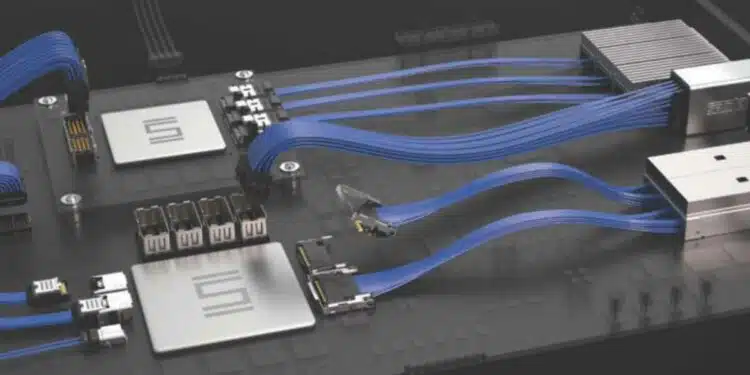Samtec unveils high-speed twinax cable for flyover assemblies, addressing the growing scrutiny of signal transmission characteristics on PCBs. As signal limits were reached, designers turned to high-speed twinax cable, enabling signal off-board configurations like the commercially introduced Samtec Flyover® system.
Samtec achieved commercial success with Flyover cable assemblies, prompting other vendors to follow suit. Fully dedicated to cable design and fabrication, Samtec continues to advance high-speed twinax cable with the introduction of Eye Speed® Hyper Low Skew Twinax.
Understanding Skew’s Impact
Skew, a critical design concern for 224 Gbps PAM4, manifests as delay differences within a differential pair due to physical and electrical channel construction. Samtec conducted extensive R&D to assess the skew impact on both Flyover twinax and PCB traces.
Tightly coupled, co-extruded twinax cable with drainless shield construction, exemplified by the Eye Speed product family, offers superior skew performance (alongside impedance and insertion loss stability) even under realistic bending conditions. This allows skew to be precisely controlled by the implementer, unlike other manufacturing techniques for twinax cable that lack co-extrusion.
Across the industry, skew is under increased scrutiny due to its potential to cause excessive signal performance variation. Samtec’s R&D revealed that precisely constraining the conductors relative to each other can maintain signal stability. This is evident in Samtec’s Eye Speed® Twinax and Eye Speed Hyper Low Skew Twinax.
Eye Speed Hyper Low Skew Twinax, meticulously crafted to address the demanding requirements of 224 Gbps PAM4 applications, offers unparalleled high-speed performance extending up to 60+ GHz Nyquist frequencies. With a maximum intrapair skew of just 1.75 ps/m, Samtec’s Hyper Low Skew Twinax stands as the industry’s leading digital differential pair transmission line, delivering exceptional signal stability.
Compact Design
In the realm of cable management, system architects face significant challenges due to the intricate designs that incorporate tight bends, high flex cycles, and extensive temperature ranges. Samtec’s R&D team has addressed this concern by introducing innovative solutions. The release of 34 AWG (EyeSpeed ThinaxTM for 112 Gbps) and 32 AWG (for 224 Gbps Eye Speed® Twinax) cables has revolutionized cable management. These compact gauges facilitate easier routing through crowded systems, significantly enhancing system efficiency.
Design Flexibility
System architects design for a diverse array of complex and captivating applications. Sometimes, the cable/connector combination they require simply doesn’t exist. To cater to this demand, Samtec’s Sudden Service® initiative introduces a unique approach with Eye Speed cables. This innovative concept allows designers to specify the connector at each end of the cable assembly, providing a comprehensive mix-and-match option. Popular mixed-end designs include ExaMAX® to AcceleRate® and FQSFP-D8 to NovaRay®.
The mix-and-match strategy enables system architects to select Samtec high-speed cable solutions for various applications, including mid-board to mid-board, near-chip to front panel, and ASIC-adjacent to the backplane. Whether the cable assemblies are PCB-attach or Direct-attach, Samtec’s HDR Group, comprising knowledgeable Application Engineers, can propose and tailor solutions that meet the specific customer application requirements.
Currently, the EyeSpeed product family page offers the following cable types: 32 AWG EyeSpeed Hyper Low Skew Twinax for inside-the-box solutions, with 27 AWG in development for longer reach cabled backplane systems.






























